
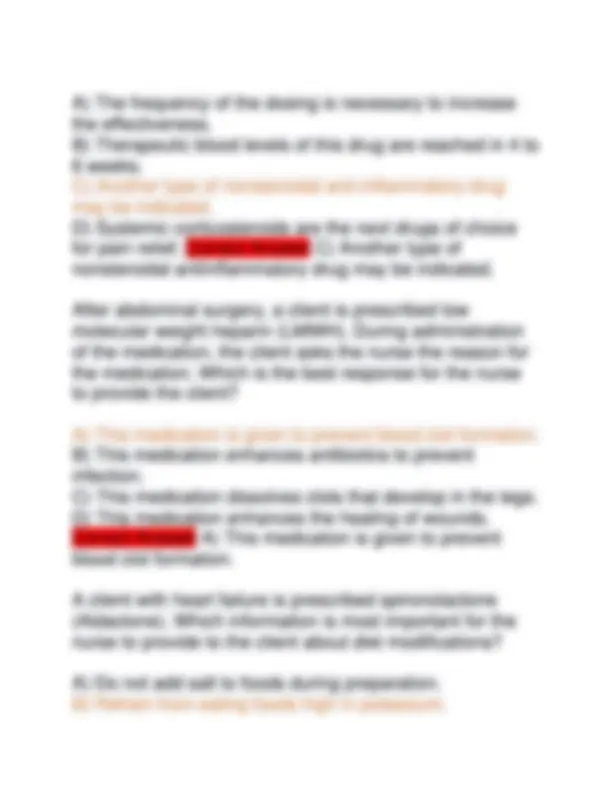
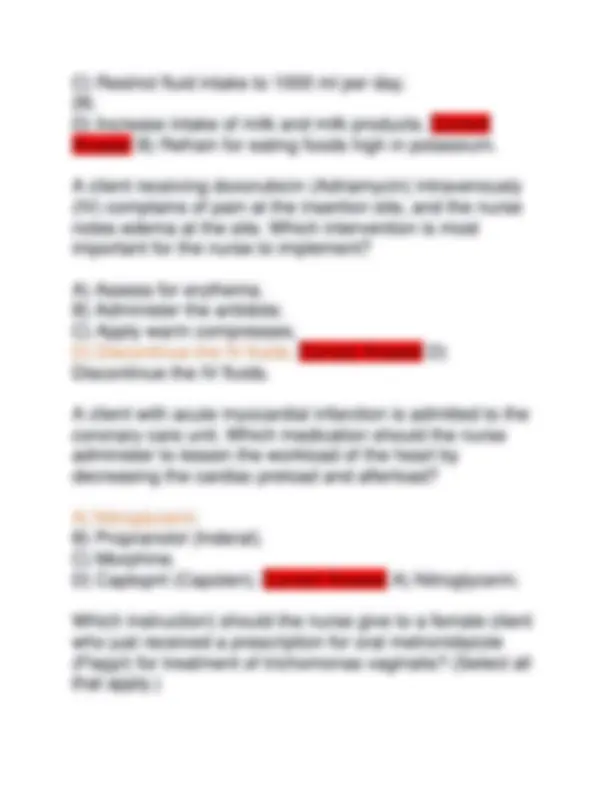
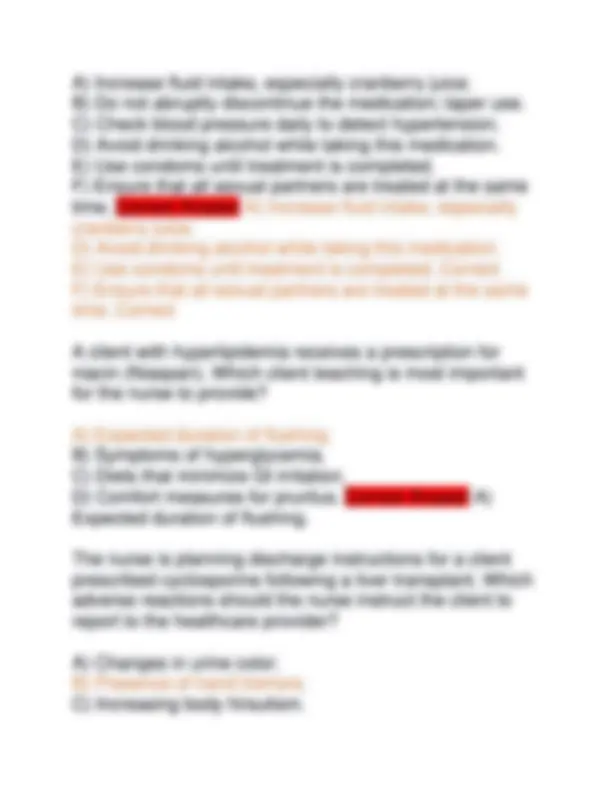
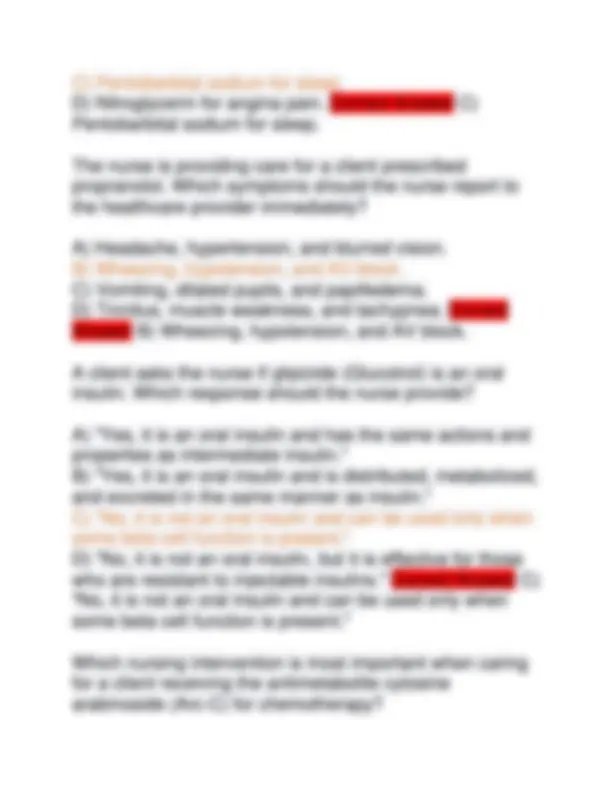
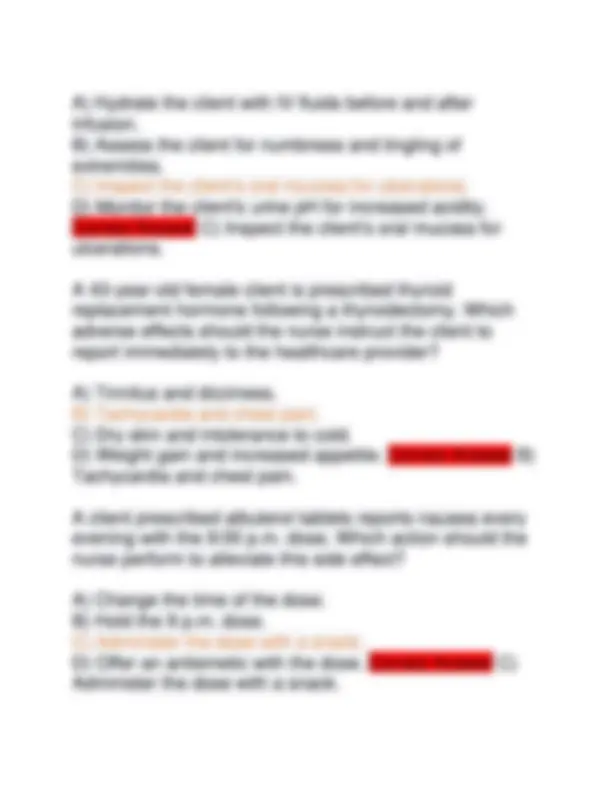
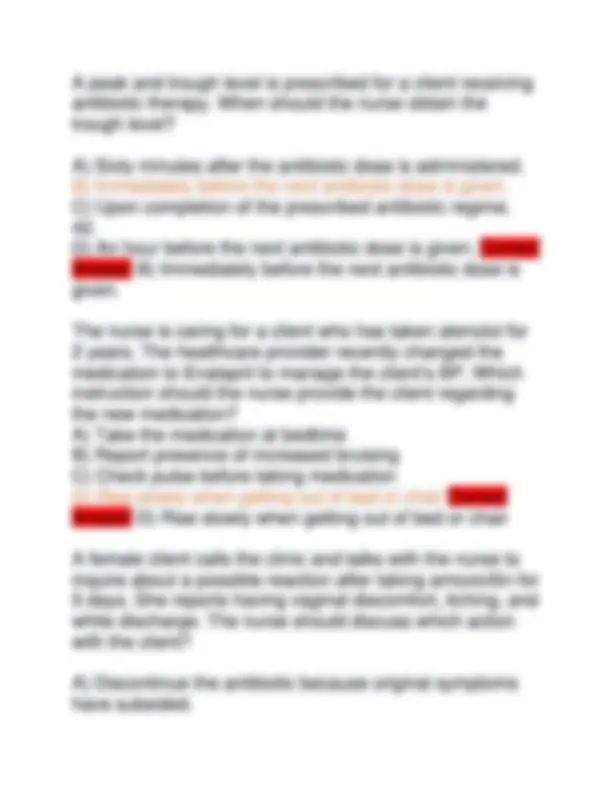
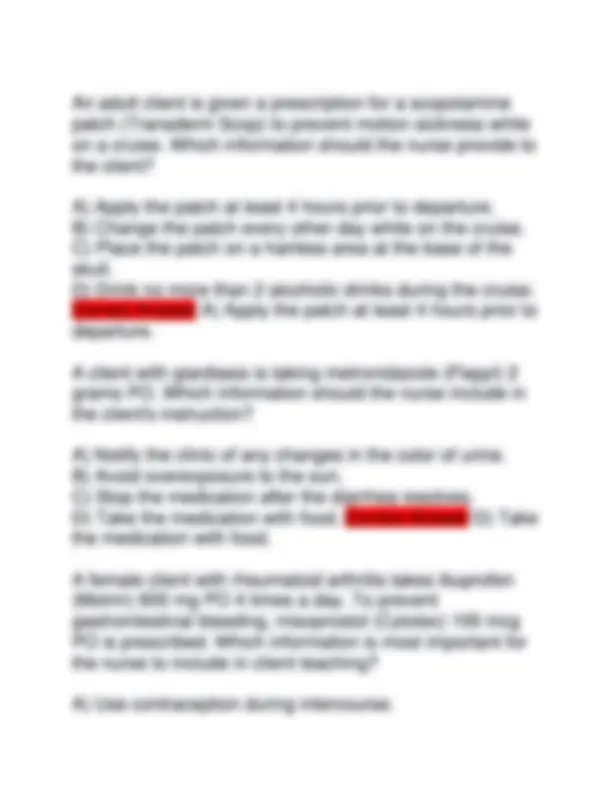

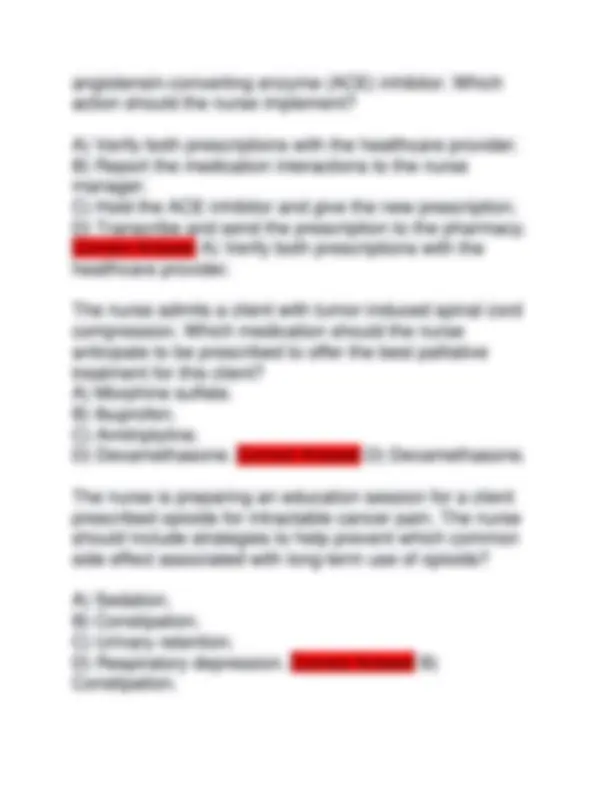
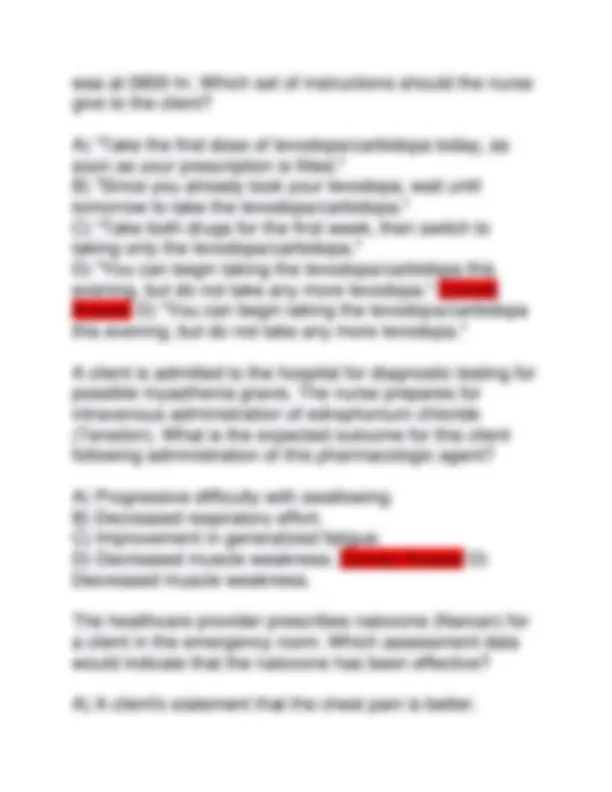
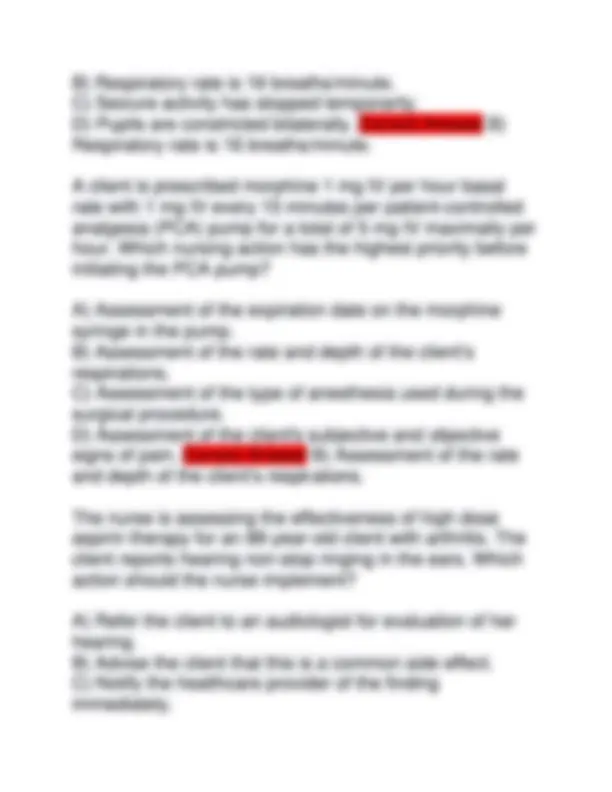
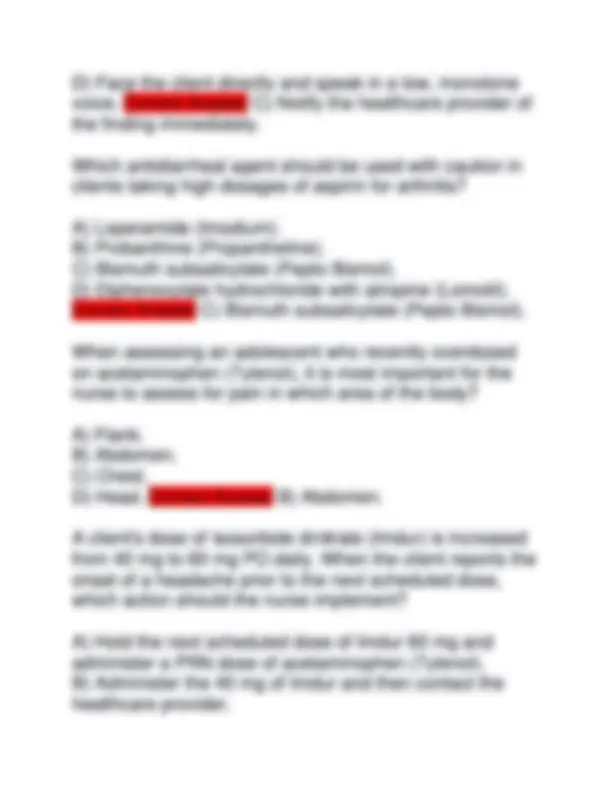
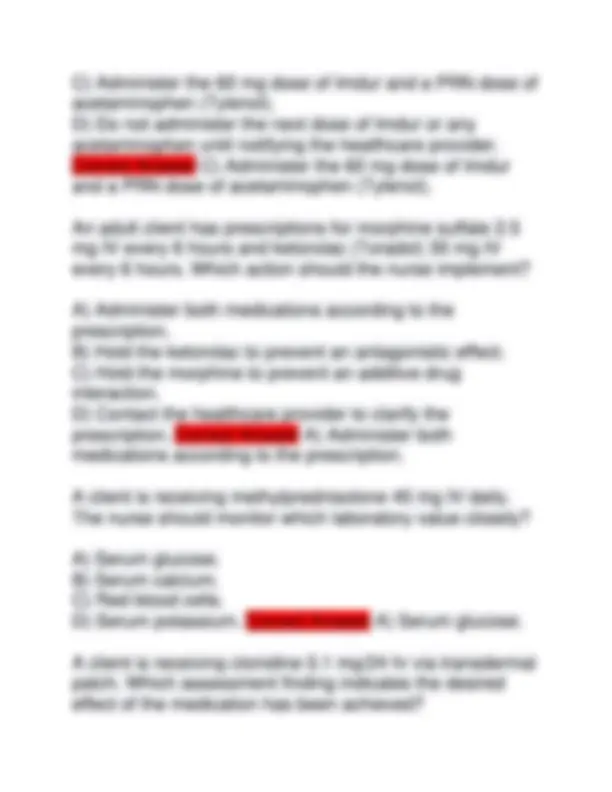
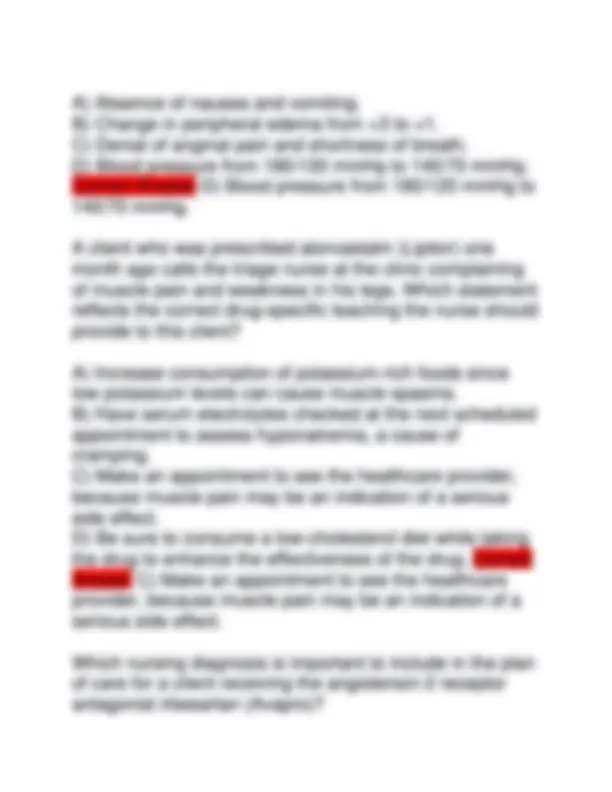
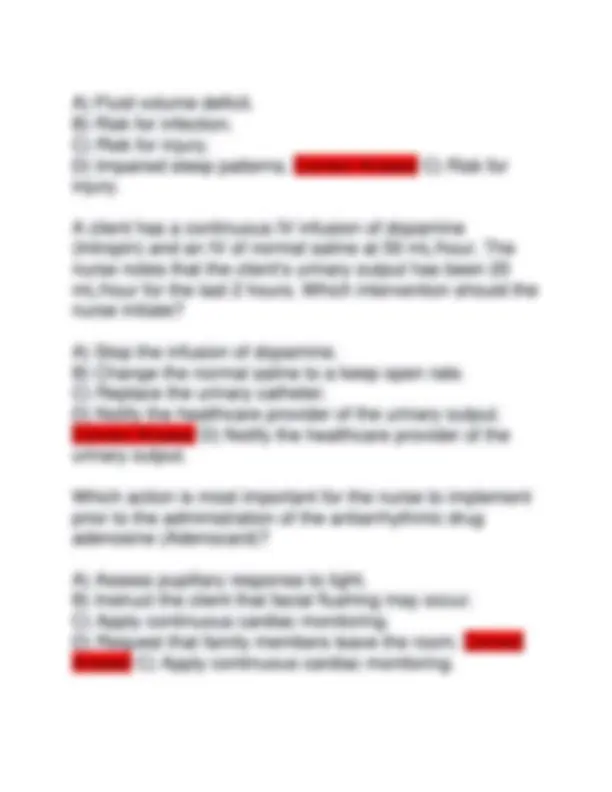
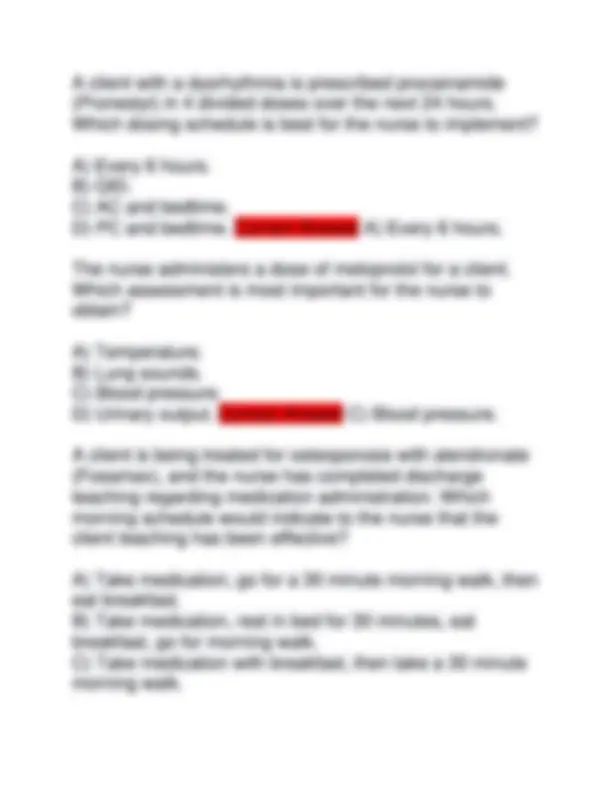
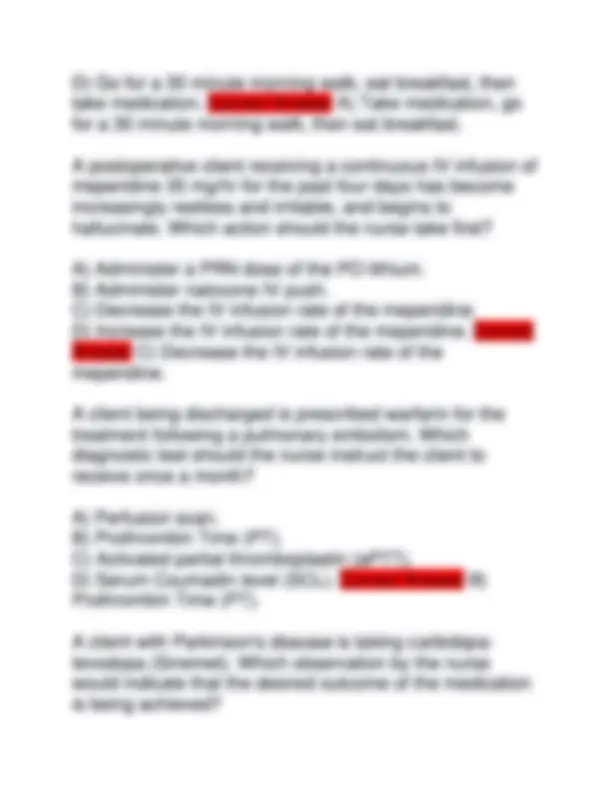
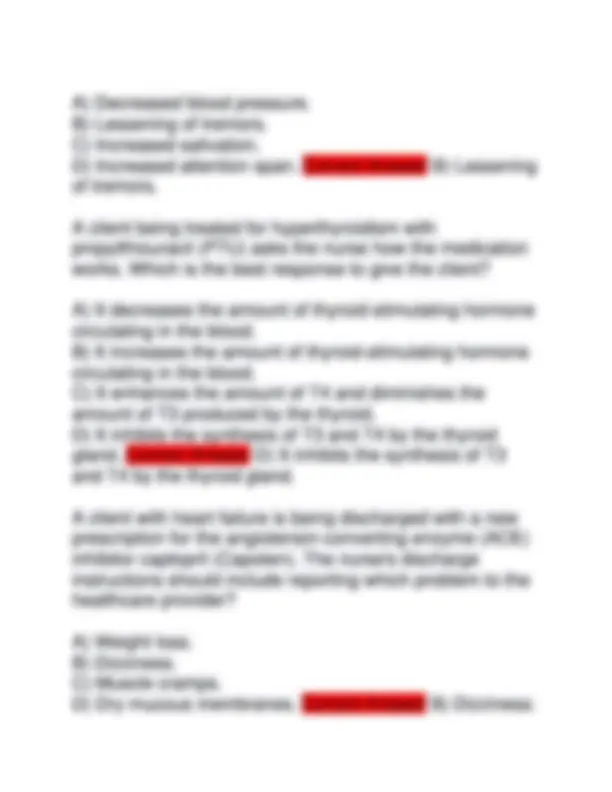
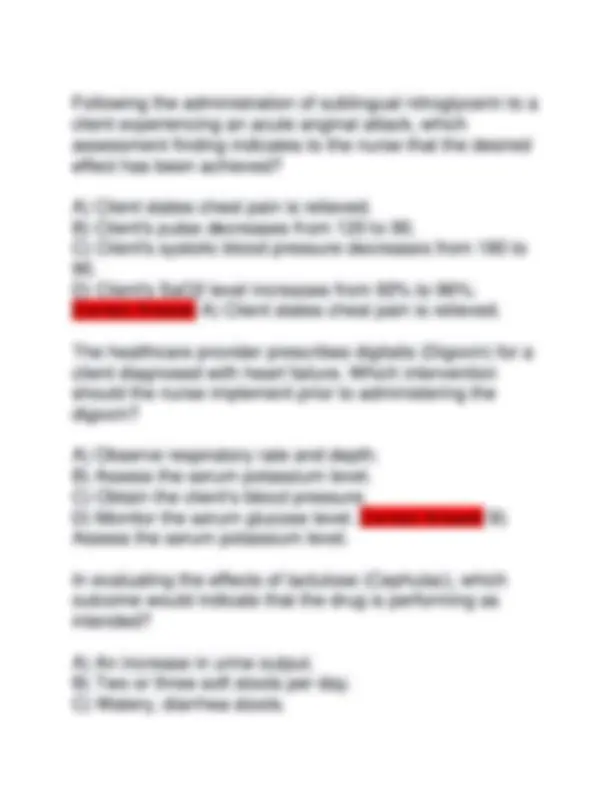
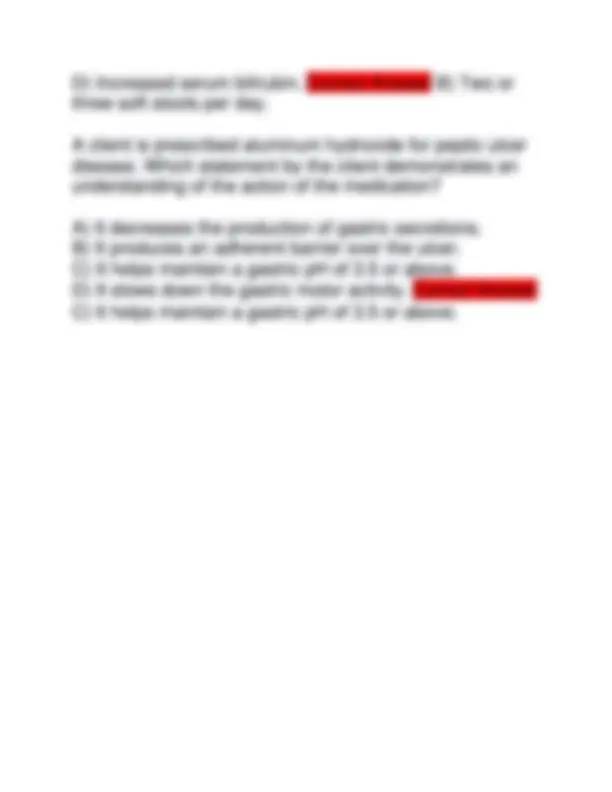


Study with the several resources on Docsity

Earn points by helping other students or get them with a premium plan


Prepare for your exams
Study with the several resources on Docsity

Earn points to download
Earn points by helping other students or get them with a premium plan
Community
Ask the community for help and clear up your study doubts
Discover the best universities in your country according to Docsity users
Free resources
Download our free guides on studying techniques, anxiety management strategies, and thesis advice from Docsity tutors
2025 HESI PHARM II BSN 315 LATEST QUESTIONS AND DETAILED CORRECT ANSWERS (VERIFIED ANSWERS) | A+ GRADE
Typology: Exams
1 / 28

This page cannot be seen from the preview
Don't miss anything!





















A client is experiencing anaphylaxis from an insect sting. Which medication should the nurse administer? A) Dopamine B) Ephedrine C) Epinephrine. D) Diphenhydramine. Correct Answer C) Epinephrine. The healthcare provider prescribes a beta-1 agonist medication to be administered. The nurse should anticipate the medication to be prescribed for a client diagnosed with which condition? A) Glaucoma. B) Hypertension. C) Heart failure. D) Asthma. Correct Answer C) Heart failure. An older client with a decreased percentage of lean body mass is admitted to the hospital. Which pharmacokinetic process is affected and should be considered in the client's dosing of medication?
A) Absorption. B) Metabolism. C) Elimination. D) Distribution. Correct Answer D) Distribution. A Category X drug is prescribed for a young adult female client. Which instruction is most important for the nurse to teach this client? A) Use a reliable form of birth control. B) Avoid exposure to ultra violet light. C) Refuse this medication if planning pregnancy. D) Abstain from intercourse while on this drug. Correct Answer A) Use a reliable form of birth control. A client being discharged home is prescribed an antibiotic with a dosage three times higher than it was administered when the client was in the hospital. Which route of administration should the nurse anticipate will be prescribed for the greatest first-pass effect? A) Oral. B) Sublingual. C) Intravenous. D) Subcutaneous. Correct Answer A) Oral. The healthcare provider prescribes naproxen (Naproxen) twice daily for a client with osteoarthritis of the hands. The client tells the nurse that the drug does not seem to be effective after three weeks. Which is the best response for the nurse to provide?
C) Restrict fluid intake to 1000 ml per day.
D) Increase intake of milk and milk products. Correct Answer B) Refrain for eating foods high in potassium. A client receiving doxorubicin (Adriamycin) intravenously (IV) complains of pain at the insertion site, and the nurse notes edema at the site. Which intervention is most important for the nurse to implement? A) Assess for erythema. B) Administer the antidote. C) Apply warm compresses. D) Discontinue the IV fluids. Correct Answer D) Discontinue the IV fluids. A client with acute myocardial infarction is admitted to the coronary care unit. Which medication should the nurse administer to lessen the workload of the heart by decreasing the cardiac preload and afterload? A) Nitroglycerin. B) Propranolol (Inderal). C) Morphine. D) Captopril (Capoten). Correct Answer A) Nitroglycerin. Which instruction) should the nurse give to a female client who just received a prescription for oral metronidazole (Flagyl) for treatment of trichomonas vaginalis? (Select all that apply.)
A) Increase fluid intake, especially cranberry juice. B) Do not abruptly discontinue the medication; taper use. C) Check blood pressure daily to detect hypertension. D) Avoid drinking alcohol while taking this medication. E) Use condoms until treatment is completed. F) Ensure that all sexual partners are treated at the same time. Correct Answer A) Increase fluid intake, especially cranberry juice. D) Avoid drinking alcohol while taking this medication. E) Use condoms until treatment is completed. Correct F) Ensure that all sexual partners are treated at the same time. Correct A client with hyperlipidemia receives a prescription for niacin (Niaspan). Which client teaching is most important for the nurse to provide? A) Expected duration of flushing. B) Symptoms of hyperglycemia. C) Diets that minimize GI irritation. D) Comfort measures for pruritus. Correct Answer A) Expected duration of flushing. The nurse is planning discharge instructions for a client prescribed cyclosporine following a liver transplant. Which adverse reactions should the nurse instruct the client to report to the healthcare provider? A) Changes in urine color. B) Presence of hand tremors. C) Increasing body hirsutism.
A client with coronary artery disease who is taking digoxin (Lanoxin) receives a new prescription for atorvastatin (Lipitor). Two weeks after initiation of the Lipitor prescription, the nurse assesses the client. Which finding requires the most immediate intervention? A) Heartburn. B) Headache. C) Constipation. D) Vomiting. Correct Answer D) Vomiting. The nitrate isosorbide dinitrate is prescribed for a client with angina. Which instruction should the nurse include in this client's discharge teaching plan? A) Quit taking the medication if dizziness occurs. B) Do not get up quickly. Always rise slowly. C) Take the medication with food only. D) Increase your intake of potassium-rich foods. Correct Answer B) Do not get up quickly. Always rise slowly. The nurse is reviewing admission prescriptions for a client with myxedema. The nurse should clarify with the healthcare provider which prescription for the client? A) Liothyronine to replace iodine. B) Furosemid for relief of fluid retention.
C) Pentobarbital sodium for sleep. D) Nitroglycerin for angina pain. Correct Answer C) Pentobarbital sodium for sleep. The nurse is providing care for a client prescribed propranolol. Which symptoms should the nurse report to the healthcare provider immediately? A) Headache, hypertension, and blurred vision. B) Wheezing, hypotension, and AV block. C) Vomiting, dilated pupils, and papilledema. D) Tinnitus, muscle weakness, and tachypnea. Correct Answer B) Wheezing, hypotension, and AV block. A client asks the nurse if glipizide (Glucotrol) is an oral insulin. Which response should the nurse provide? A) "Yes, it is an oral insulin and has the same actions and properties as intermediate insulin." B) "Yes, it is an oral insulin and is distributed, metabolized, and excreted in the same manner as insulin." C) "No, it is not an oral insulin and can be used only when some beta cell function is present." D) "No, it is not an oral insulin, but it is effective for those who are resistant to injectable insulins." Correct Answer C) "No, it is not an oral insulin and can be used only when some beta cell function is present." Which nursing intervention is most important when caring for a client receiving the antimetabolite cytosine arabinoside (Arc-C) for chemotherapy?
A peak and trough level is prescribed for a client receiving antibiotic therapy. When should the nurse obtain the trough level? A) Sixty minutes after the antibiotic dose is administered. B) Immediately before the next antibiotic dose is given. C) Upon completion of the prescribed antibiotic regime.
D) An hour before the next antibiotic dose is given. Correct Answer B) Immediately before the next antibiotic dose is given. The nurse is caring for a client who has taken atenolol for 2 years. The healthcare provider recently changed the medication to Enalapril to manage the client's BP. Which instruction should the nurse provide the client regarding the new medication? A) Take the medication at bedtime B) Report presence of increased bruising C) Check pulse before taking medication D) Rise slowly when getting out of bed or chair Correct Answer D) Rise slowly when getting out of bed or chair A female client calls the clinic and talks with the nurse to inquire about a possible reaction after taking amoxicillin for 5 days. She reports having vaginal discomfort, itching, and white discharge. The nurse should discuss which action with the client? A) Discontinue the antibiotic because original symptoms have subsided.
B) Continue taking the medication until finished until the symptoms subside. C) Consult with a healthcare provider about another treatment for this effect. D) Use an over-the-counter (OTC) vaginal wash to flush out the secretions. Correct Answer C) Consult with healthcare provider about another treatment for this effect. The nurse is making early morning rounds on a group of clients when a client begins exhibiting symptoms of an acute asthma attack. The nurse administers a PRN prescription for a Beta 2 receptor agonist agent. Which client response should the nurse expect? [Select all apply] A) Tachycardia. B) Increased blood pressure. C) Rapid resolution of wheezing. D) Improved pulse oximetry values. E) Reduce fever airway inflammation. Correct Answer C) Rapid resolution of wheezing. D) Improved pulse oximetry values. A client prescribed atenolol has a blood pressure of 120/68 mmHg, displaying sinus bradycardia with a rate of 58 beats/minute, and a P-R interval of 0.24. Which action should the nurse take? A) Lower the head of the bed and assess the client for orthostatic vital sign changes. B) Give the medication as prescribed and continue to monitor the client.
An adult client is given a prescription for a scopolamine patch (Transderm Scop) to prevent motion sickness while on a cruise. Which information should the nurse provide to the client? A) Apply the patch at least 4 hours prior to departure. B) Change the patch every other day while on the cruise. C) Place the patch on a hairless area at the base of the skull. D) Drink no more than 2 alcoholic drinks during the cruise. Correct Answer A) Apply the patch at least 4 hours prior to departure. A client with giardiasis is taking metronidazole (Flagyl) 2 grams PO. Which information should the nurse include in the client's instruction? A) Notify the clinic of any changes in the color of urine. B) Avoid overexposure to the sun. C) Stop the medication after the diarrhea resolves. D) Take the medication with food. Correct Answer D) Take the medication with food. A female client with rheumatoid arthritis takes ibuprofen (Motrin) 600 mg PO 4 times a day. To prevent gastrointestinal bleeding, misoprostol (Cytotec) 100 mcg PO is prescribed. Which information is most important for the nurse to include in client teaching? A) Use contraception during intercourse.
B) Ensure the Cytotec is taken on an empty stomach. C) Encourage oral fluid intake to prevent constipation. D) Take Cytotec 30 minutes prior to Motrin. Correct Answer A) Use contraception during intercourse. A client with osteoarthritis receives a new prescription for celecoxib (Celebrex) orally for symptom management. The nurse notes the client is allergic to sulfa. Which action is most important for the nurse to implement prior to administering the first dose? A) Review the client's hemoglobin results. B) Notify the healthcare provider. C) Inquire about the reaction to sulfa. D) Record the client's vital signs. Correct Answer B) Notify the healthcare provider. A client is admitted to the hospital for new onset of supraventricular tachycardia (SVT) and is prescribed digoxin. For which laboratory finding should the nurse notify the healthcare provider immediately? A) Potassium level of 3.1 mEq/L. B) Sodium level of 132 mEq/L. C) Calcium level of 8.6 mg/dL. D) Magnesium level of 1.2 mEq/L. Correct Answer A) Potassium level of 3.1 mEq/L. The nurse is transcribing a new prescription for spironolactone (Aldactone) for a client who receives an
A client is prescribed controlled-release oxycodone. Which dosing schedule is best for the nurse to teach the client? A) As needed. B) Every 12 hours. C) Every 24 hours. D) Every 4 to 6 hours. Correct Answer B) Every 12 hours. Which client should the nurse identify as being at highest risk for complications during the use of an opioid analgesic? A) An older client with Type 2 diabetes mellitus. B) A client with chronic rheumatoid arthritis. C) A client with a open compound fracture. D) A young adult with inflammatory bowel disease. Correct Answer D) A young adult with inflammatory bowel disease. Which medications should the nurse caution the client about taking while receiving an opioid analgesic? A) Antacids. B) Benzodiazepines. C) Antihypertensives. D) Oral antidiabetics. Correct Answer B) Benzodiazepines. A client is prescribed 1 mcg/kg/min of dobutamine hydrochloride via IV infusion. Which client's condition would benefit the most from an administration of dobutamine hydrochloride?
A) Shock. B) Asthma. C) Hypotension. D) Heart failure. Correct Answer D) Heart failure. A client is prescribed ampicillin sodium (Omnipen) for a sinus infection. The nurse should instruct the client to notify the healthcare provider immediately if which symptom occurs? A) Rash. B) Nausea. C) Headache. D) Dizziness. Correct Answer A) Rash. While taking a medical history, the client states, "I am allergic to penicillin." What related allergy to another type of antiinfective agent should the nurse ask the client about when taking the nursing history? A) Aminoglycosides. B) Cephalosporins. C) Sulfonamides. D) Tetracyclines. Correct Answer B) Cephalosporins. A client receives a new prescription for sustained release levodopa/carbidopa PO BID for the treatment of Parkinson's disease. The client's previous prescription was levodopa PO TID. The client's last dose of levodopa
B) Respiratory rate is 16 breaths/minute. C) Seizure activity has stopped temporarily. D) Pupils are constricted bilaterally. Correct Answer B) Respiratory rate is 16 breaths/minute. A client is prescribed morphine 1 mg IV per hour basal rate with 1 mg IV every 15 minutes per patient-controlled analgesia (PCA) pump for a total of 5 mg IV maximally per hour. Which nursing action has the highest priority before initiating the PCA pump? A) Assessment of the expiration date on the morphine syringe in the pump. B) Assessment of the rate and depth of the client's respirations. C) Assessment of the type of anesthesia used during the surgical procedure. D) Assessment of the client's subjective and objective signs of pain. Correct Answer B) Assessment of the rate and depth of the client's respirations. The nurse is assessing the effectiveness of high dose aspirin therapy for an 88-year-old client with arthritis. The client reports hearing non-stop ringing in the ears. Which action should the nurse implement? A) Refer the client to an audiologist for evaluation of her hearing. B) Advise the client that this is a common side effect. C) Notify the healthcare provider of the finding immediately.
D) Face the client directly and speak in a low, monotone voice. Correct Answer C) Notify the healthcare provider of the finding immediately. Which antidiarrheal agent should be used with caution in clients taking high dosages of aspirin for arthritis? A) Loperamide (Imodium). B) Probanthine (Propantheline). C) Bismuth subsalicylate (Pepto Bismol). D) Diphenoxylate hydrochloride with atropine (Lomotil). Correct Answer C) Bismuth subsalicylate (Pepto Bismol). When assessing an adolescent who recently overdosed on acetaminophen (Tylenol), it is most important for the nurse to assess for pain in which area of the body? A) Flank. B) Abdomen. C) Chest. D) Head. Correct Answer B) Abdomen. A client's dose of isosorbide dinitrate (Imdur) is increased from 40 mg to 60 mg PO daily. When the client reports the onset of a headache prior to the next scheduled dose, which action should the nurse implement? A) Hold the next scheduled dose of Imdur 60 mg and administer a PRN dose of acetaminophen (Tylenol). B) Administer the 40 mg of Imdur and then contact the healthcare provider.